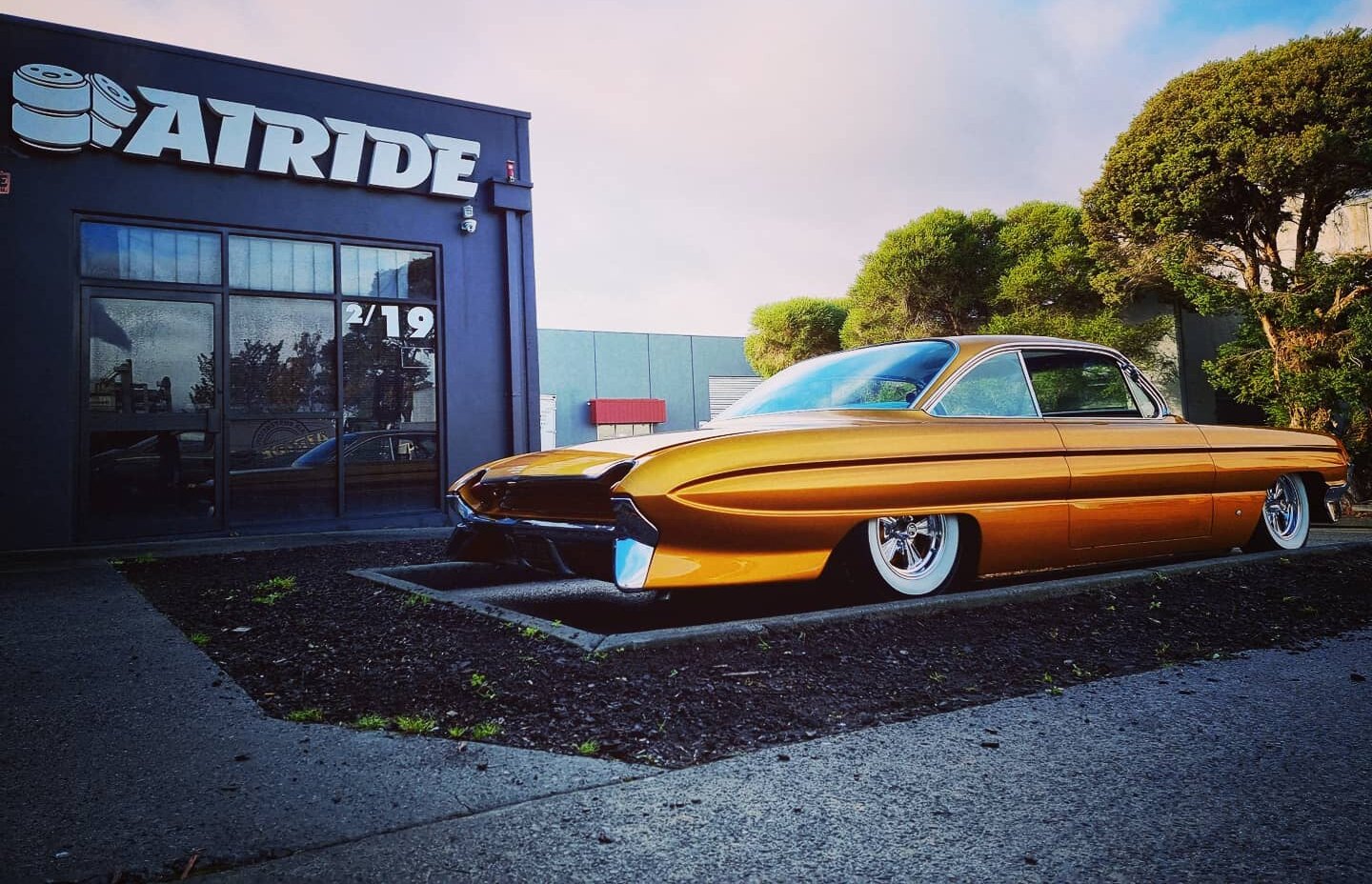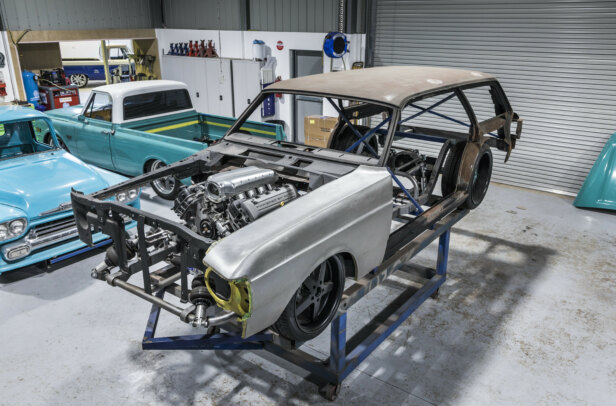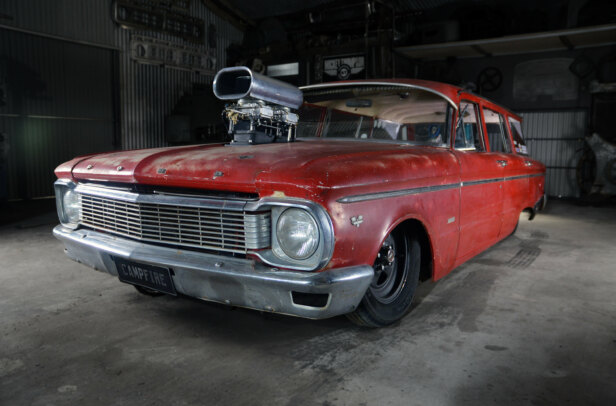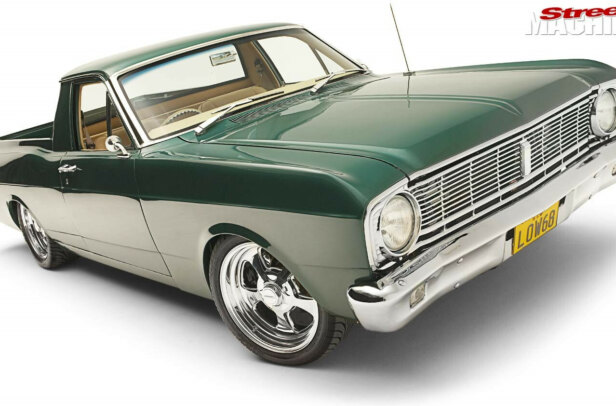WE ALL love seeing a tough car slammed to the ground, but they can be a royal pain to live with. Getting in and out of driveways, over speed humps or down our rough highways without taking the sump, exhaust or undercarriage out is a real challenge, and this is where airbag suspension provides an awesome solution.
Aaron Gregory from Memphis Hell (that’s his ’51 Chev, above) has been installing air suspension in all manner of vehicles for over 10 years, and he’s seen the industry change dramatically in its packaging and brain-power.
“While Slam Specialties brought out airbags with internal bump stops and springs comparable to coil-overs, the single biggest improvement has been the technology controlling the air systems,” says Aaron. “Companies like Air Lift and the recently defunct AccuAir have auto-levelling systems and that make the car much nicer to drive. It doesn’t matter if it’s a nice old full-size Chevy filled with mates and Eskys in the back or a late-model HSV ute with a tray full of concrete bags, the height management systems will keep the car exactly at the pre-programmed ride height and perfectly level.”
AccuAir has long been one of the industry leaders in airbag technology. As the brains of the company’s e-Level height management system, this ECU features four connectors that link it to the handset, the valve block, the height sensors and the compressor(s)
However, while airbag suspension might seem like a quick and easy path to killer stance and improved practicality, there are several important factors to consider before racing out to buy a kit, including budget.
“I have a bit of a niche where people want me to build them a car that sits on the ground, so wheels, drivetrain and engine bay all have to go somewhere and that is upwards, which means lots of fabrication,” says Aaron. “People see you can buy a ‘kit’ for $4500, but that is the cheap and easy part. If you want to get your car engineered, which you should, then you’re over $6000 for a height management and auto-levelling system, so you can’t change the car’s height unless the handbrake is on.”
With many late-model cars using MacPherson struts, there are a range of companies offering bolt-in style air suspension kits like this dual-adjustable option
While he’s long been a member of the Negative Camber mini-truck club, Aaron points out that airbags offer more than just being able to sit your sills on the deck. “It’s not always about going low; sometimes you need to go high,” he says. “Load-assist is another massive sector of the air industry, probably more so than having a car lie flat on the ground. I had a bloke with a ’36 Dodge truck get in contact who just wanted an airbag on the diff with a switch so he didn’t rip his back bumper off when he drove out his driveway with a load on the back.”
In the past there has been concern at perceived difficulties in attaining engineering approval for airbag set-ups, and this has led to some confusion and myths around pneumatically adjustable suspension systems. Aaron has heard them all, and laughs them off. “People say airbags are no good for race cars, but some Pro Mods are apparently now running air suspension,” he says. “They run pumped up through the burnout and, once the tyre has finished expanding, about halfway into the run the bags drop to improve aero.
Nylon or plastic air line needs to be squarely cut and free of damage to prevent leaks in the system
“One big myth is that you can’t have an air system that doesn’t leak,” he continues. “The system won’t leak if you put thread sealer on your fittings, use DOT push-to-connect fittings and DOT-approved air lines, and cut the air line clean and square. My truck can be parked for three months and it doesn’t move a millimetre.
“You also need to watch for condensation in the tank as that can lead to rust in the valves, which brings on a world of problems. Nothing should touch an airbag, as that will end up rubbing a hole, and air line needs to be treated with the same logic as fuel line: it can’t touch anything.”
AccuAir’s e-Level height management system relies on these four height sensors. Each sensor is mounted to a corner of the chassis, with the strut rods connected to a control arm nearby to provide a reference to the e-Level ECU
Technology has also improved the ease of fitting air systems, in Aaron’s experience, though it is still not a job for a total mechanical novice. “With the Air Lift system I fitted to an S550 Mustang recently, I had one ground, one power and one ignition power wire and that is all I needed to wire in. The rest is all pre-terminated, so you just plug it in. You have to be super-thorough with the installation for the AccuAir e-Level height sensors in terms of measurements and cleanliness, but once you get them done right, they’ll live forever.”
AIR SUPPLY
AIR Ride Suspension Supplies in Bayswater, Melbourne, has been supplying air systems since 1997, and the crew there has since seen the industry grow into the juggernaut it is today. We hit up managing director David Rulach to get the good oil on modern air systems.
What have been the biggest improvements in air suspension set-ups over the past 20 years?
Pressure-based systems have been taken over by height-control systems, allowing for super-accurate, computer-controlled ride heights, while modern valves are now very compact and can come with flow controls, internal filters and hidden wiring. AccuAir’s ENDO-CVT sees the tank house the compressors and valves internally, making them almost silent and allowing a super-clean installation.
What’s the latest fashion in air suspension installations?
It’s pretty popular to have the air tanks and valves on display, and a lot of people are now doing hard lines to finish off their installation and to make it unique.
What is the number one thing to consider before buying an air suspension system?
Think about what system you’re after: if it’s a two- or four-way system; how low you want to go; and if it’s going to be engineer-approved. Some vehicles require front and rear ends to be changed, as factory suspension designs don’t always allow you to achieve the results you’re after, and this can lead to lots of fabrication and engineering work, which you then have to factor in as additional costs on top of the air suspension kit.
Do you need more tanks/capacity in larger cars?
Big, heavy cars can require more air and air pressure than a typical vehicle. We always recommend running dual compressors and higher air pressures in the bags for heavier cars, which will speed up the tank fill time. We recommend a five-gallon tank as a minimum for front and rear systems, while three-gallon tanks are big enough for a system that only works on the rear or front.
What mistakes are people making when setting up their air suspension?
The biggest issues include people rushing their installation, poorly sealed fittings causing air leaks, installers not checking bag clearance during and after installation, people using cheap parts that don’t last long, installers cutting the air line poorly, and bad power or earth connections.
IN DETAIL:
1. The valve block is responsible for controlling air pressure going to each of the four air springs in a system. This is from AccuAir’s VX4 unit.
2. This Air Ride-made control panel is designed for manual adjustment, with the Viair gauges showing air pressure and the four rocker switches allowing pressure adjustments.
3. These Air Ride ShockWave air struts offer an excellent mix of height adjustability and handling performance, and are being used in quite a few Optima Challenge pro touring race cars in the USA. They are offered in a variety of diameters and heights, with different air springs for different load types.
4. Bellows-type airbags need well-engineered mounts using thick-gauge steel, as these two types of mounts show.
5. This is a traditional-style airbag installation, using a bellows-type bag and separate shock absorber, mocked up on a parallel four-link rear.
6. This cutaway AccuAir ENDO-CVT shows how the WABCO compressor and valve block are mounted inside the air tank for near-silent operation and a super-clean installation. A desiccant air dryer prevents humidity building up as the tank cycles air.
7. AccuAir’s touchpad controller works with its e-Level system to manage suspension height. One is slammed, two is set to 50 per cent of the car’s suspension travel and three is maximum height. The other buttons manually control each corner, or each end.
8. This front suspension set-up shows one type of air strut, which uses an air spring mounted around a shock body.
9. If you can’t hide the air set-up, why not make it a feature? While many systems run cheap and easy-to-fit plastic air line, the hot trend is to replace these with custom-bent metal hard lines.
1. Airbags
Compressed air is fed from a tank to rubber bladders that replace coil or leaf springs at each corner of the car. The air springs can be the traditional ‘bellows’ type (a standalone rubber bladder) or a strut (a rubber air spring mounted over a shock absorber).
2. ECU
Some air management systems rely on air pressure settings to stay at preset ride heights, while others use height sensors at each corner wired to an ECU to provide reference points and load-levelling capabilities. These systems also make it a cinch to get your air system engineered
3. Controller/handset
A controller is used by the driver to switch between preset ride heights, or to manually adjust the air pressure across the front or rear ends or individual corners. The latest systems use mobile apps so owners can use their phone to control their airbags.
4. Compressors
Previously, some air systems used an engine-mounted air conditioning compressor to provide pressurised air to the tank; modern compressor designs have largely superseded this. Today it is normal to have at least one external air compressor to maintain pressure inside the tank. The larger and heavier the car, the more likely you’ll need two or more large-capacity compressors.
5. Mounts
Thick-gauge plates need to be welded in for the airbags to be bolted into. Huge loads are pushed through the mounts, so they need to be quality, like these Air Ride-made items.
6. Water trap
As air is compressed, it is heated up, which can lead to water building up inside the tank, so it is important to have a water trap and drain set-up to bleed this moisture out of the system.
7. Air tank
Offered in various capacities, air tanks hold the compressed air required to inflate the air springs. Normally plumbed to external compressors, some new systems offer the ability to have the compressor and valve block mounted inside the tank for a very clean, quiet installation. If you use your car a lot, it is important to drain the tank and check the water trap to prevent moisture building up internally and causing issues with valves.
8. Air lines
Tying the whole system together are the lines used to carry compressed air between the tank and the airbags, which can be either steel hard line or a DOT-rated plastic hose. Sizing of the lines depends on how fast-acting the system needs to be, and the size and weight of the vehicle, but most large cars (Kingswood, Falcon or Impala) would run 3/8in for smooth operation.




Comments